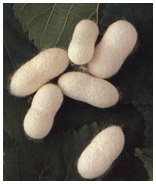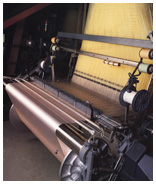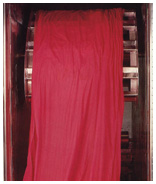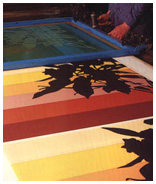How Silk is Produced
Production of Silk

Silk is produced by various insects, but by far the largest quantity comes from the silkworm 'Bombyx Mori'. This is the silk worm, which feeds on mulberry leaves and forms a cocoon of Silk before pupating. The threads from several cocoons are subsequently unwound together to form a single strand of raw silk. This fine thread is the basic component of all Silk yarn and fabric. Some of the gum, which the silkworm uses to hold the cocoon together, remains to assist the delicate fibre during processing. It is subsequently washed away.
|

Weaving is the operation that creates a fabric by interlacing the warp yarns (lengthwise) and the weft yarns. Weaving is carried out on looms, after a series of preliminary operations including:
In the past twenty years, enormous strides have been made in improving not only the machines involved in the preparation of weaving, but in the loom itself. Non-stop weaving has been made possible by the introduction of automatic pirnchanging. And there are now shuttleless looms, (more properly called weaving machines). These machines use lances, or projectiles, or a jet of compressed air to shoot the weft-yarn between the warp-yarns, instead of the traditional shuttle, and at vastly higher speeds. This increased automation also meant that one weaving-worker can now look after 20 looms at the same time, instead of only 4 traditional looms. This has consequently led to much greater yield and productivity. Some of the modern weaving machines are large enough to weave fabrics 3 metres wide. In addition to their greater speeds these machines also offer the advantage for the weaver of enabling him to divide this large width into several smaller widths, for example 3 times 90 centimetres. Although modem weaving machinery has made enormous progress, certain specific types of silk can only be made on ordinary looms, as they are too complex to be woven on highly-automated machines, running at very high speeds. This is notably the case for high-novelty fabrics, and even more so for the reproduction of traditional fabrics used for wallcoverings, upholstery etc. Many of these fabrics are produced on Jacquard looms, called after their Lyonnais inventor, who in 1801 perfected the existing system of patternweaving, by the use of perforated cards. The Jacquard loom makes it possible to weave intricate and multi-coloured patterns directly into the fabric, and thus create highly elaborate and handsome fabrics. As soon as they come off the loom, the fabrics are thoroughly inspected so as to eliminate any defects that may have occurred during weaving. |
There are two main types of silk fabrics, each with its own specific characteristics:
In both cases, yarn-dyed or piece-dyed, the dyeing operation is always preceded by boiling-off, a process in which the gum (sericin) is removed from the fibre. This results in a weight loss of 20-25%. In some cases, this loss is made up for by the addition of vegetable or mineral substances, which the fibre absorbs in order to have better "body" when this is required for certain end-uses.
- The first category includes those fabrics made from yarns which have been dyed beforehand: these fabrics are known as yarn-dyed or dyed-woven (eg, taffeta, duchess satin, many pattern-woven fabrics)
- The second type includes all those fabrics that are dyed after weaving, known as piece-dyed fabrics (eg, crepes, twills, etc).
In both cases, yarn-dyed or piece-dyed, the dyeing operation is always preceded by boiling-off, a process in which the gum (sericin) is removed from the fibre. This results in a weight loss of 20-25%. In some cases, this loss is made up for by the addition of vegetable or mineral substances, which the fibre absorbs in order to have better "body" when this is required for certain end-uses.

Dyeing
Up until about 1815-1830, only yarn-dyed fabrics were woven, as piece-dyeing was still unknown. Yarn-dyeing still uses the same basic technique, which consists of soaking the skeins of raw silk in tanks containing the dyestuff.
Piece-dyeing, introduced in Lyon, became an industrial process around 1849, and for a long time remained a speciality of Lyon Region. There are several different processes of piece-dyeing. The fabric can be fed into the dye-bath through two cylinders, or it can be fixed to a round jig which is immersed in the bath. While the fabric is attached to the jig, the dyestuff is fixed, and then the fabric is rinsed and dried.
Piece-dyeing, introduced in Lyon, became an industrial process around 1849, and for a long time remained a speciality of Lyon Region. There are several different processes of piece-dyeing. The fabric can be fed into the dye-bath through two cylinders, or it can be fixed to a round jig which is immersed in the bath. While the fabric is attached to the jig, the dyestuff is fixed, and then the fabric is rinsed and dried.

Printing
Printing consists of transferring a pattern to the fabric. Nowadays, printing is carried out in the following ways:
- Block-printing: wooden blocks are engraved with the pattern to be printed, and the raised parts of the block transfer the dyestuff to the fabrics. However, this process is slow and laborious, and today is only used on a very small scale for handicraft fabrics.
- Roller-printing: the roller-printing method was invented by the Scotsman Bell in 1785. The fabric is printed mechanically by passing through two rollers which have been engraved with the required design. This method is ideally suited to very long runs, and so is not used very often for silk fabrics.

- Screen-printing: sometimes knows as "a' la lyonnaise", becausethe city of Lyon seems to have been the first to industrialise this process around 1850. A fine gauze is stretched tightly over a metal frame, and the design to be reproduced is transferred to the gauze. By a photochemical process, the "pores" in the gauze are partially blocked off allowing the dyestuff to be squeezed through the gauze where the design is to be printed. This process enables several colours to be printed one after the other, each colour requiring one frame. The design is printed on to a white fabric, or on to fabrics already dyed with a base colour. In this case, the base colour is not fixed, so that the colours printed through the screen destroy and replace the base colour. This type of printing is particularly intended for high-novelty fabrics, which are usually produced in relatively small quantities. It is, therefore, very widely used in printing silk fabrics.
Finishing
With the exception of pattern-weavers, all fabrics have to be finished. It is the finisher who gives satin its shimmering suppleness and its "hand". Finishing gives a fabric the desired appearance and feel. There are numerous finishing processes, physical and chemical. Finishing includes treatments such as creaseproofing, water-proofing, fire-proofing, etc.
